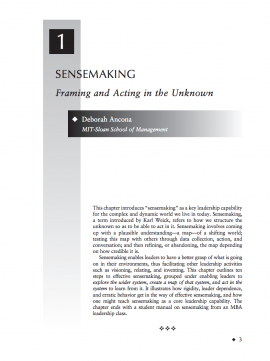Sensemaking, a term introduced by Karl Weick, refers to how we structure the unknown so as to be able to act in it. Sensemaking involves coming up with a plausible understanding—a map—of a shifting world; testing this map with others through data collection, action, and conversation; and then refining, or abandoning, the map depending on how credible it is. Sensemaking enables leaders to have a better grasp of what is going on in their environments, thus facilitating other leadership activities such as visioning, relating, and inventing. This chapter outlines ten steps to effective sensemaking, grouped under enabling leaders to explore the wider system, create a map of that system, and act in the system to learn from it. It illustrates how rigidity, leader dependence, and erratic behavior get in the way of effective sensemaking, and how one might teach sensemaking as a core leadership capability. The chapter ends with a student manual on sensemaking from an MBA leadership class.
Original Link : https://www.sagepub.com/sites/default/files/upm-binaries/42924_1.pdf



